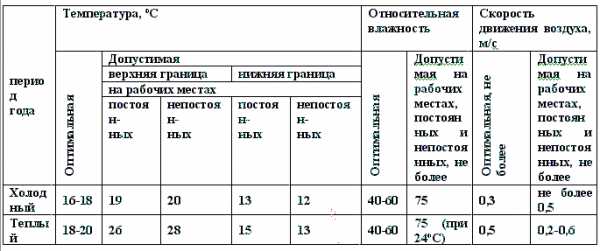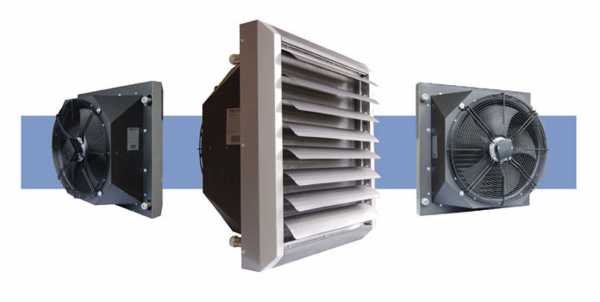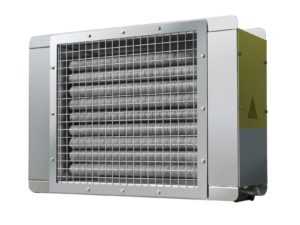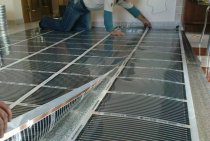CALCULATION OF ELECTRIC HEATING INSTALLATION
1.1 Thermal calculation of heating elements
The task of thermal calculation of the block of heating elements includes determining the number of heating elements in the block and the actual temperature of the surface of the heating element. The results of the thermal calculation are used to refine the design parameters of the block.
The task for the calculation is given in Appendix 1.
The power of one heating element is determined based on the power of the heater
To
The number of heating elements z is taken as a multiple of 3, and the power of one heating element should not exceed 3 ... 4 kW. The heating element is selected according to passport data (Appendix 1).
By design, blocks are distinguished with a corridor and a staggered layout of heating elements (Figure 1.1).
-
a) b) a - corridor layout; b - chess layout. Figure 1.1 - Layout diagrams of the block of heating elements
For the first row of heaters of the assembled heating block, the following condition must be met:
O
where tn1 - actual average surface temperature of the heaters of the first row, oC; Pm1 is the total power of the heaters of the first row, W; Wed— average heat transfer coefficient, W/(m2оС); FT1 - total area of the heat-releasing surface of the heaters of the first row, m2; tv - temperature of the air flow after the heater, °C.
The total power and the total area of the heaters are determined from the parameters of the selected heating elements according to the formulas
, , (1.3)
where k - the number of heating elements in a row, pcs; PT, FT - respectively, power, W, and surface area, m2, of one heating element.
Surface area of ribbed heating element
, (1.4)
where d is the diameter of the heating element, m; la – active length of the heating element, m; hR is the height of the rib, m; a - fin pitch, m
For bundles of transversely streamlined pipes, one should take into account the average heat transfer coefficient Wed, since the conditions for heat transfer by separate rows of heaters are different and are determined by the turbulence of the air flow. The heat transfer of the first and second rows of tubes is less than that of the third row. If the heat transfer of the third row of heating elements is taken as unity, then the heat transfer of the first row will be about 0.6, the second - about 0.7 in staggered bundles and about 0.9 - in the in-line from the heat transfer of the third row. For all rows after the third row, the heat transfer coefficient can be considered unchanged and equal to the heat transfer of the third row.
The heat transfer coefficient of the heating element is determined by the empirical expression
where Nu – Nusselt criterion, - coefficient of thermal conductivity of air,
= Od
The Nusselt criterion for specific heat transfer conditions is calculated from the expressions
for in-line tube bundles
at Re 1103
at Re > 1103
for staggered tube bundles:
for Re 1103, (1.8)
at Re > 1103
where Re is the Reynolds criterion.
The Reynolds criterion characterizes the air flow around the heating elements and is equal to
, (1.10)
where — air flow velocity, m/s; — coefficient of kinematic viscosity of air, = 18.510-6 m2/s.
In order to ensure an effective thermal load of heating elements that does not lead to overheating of the heaters, it is necessary to ensure air flow in the heat exchange zone at a speed of at least 6 m/s. Taking into account the increase in the aerodynamic resistance of the air duct structure and the heating block with an increase in the air flow velocity, the latter should be limited to 15 m/s.
Average heat transfer coefficient
for in-line bundles
, (1.11)
for chess beams
where n is the number of rows of pipes in the bundle of the heating block.
The temperature of the air flow after the heater is
, (1.13)
where PTo - the total power of heating elements of the heater, kW; — air density, kg/m3; Withv is the specific heat capacity of air, Withv= 1 kJ/(kgоС); Lv – air heater capacity, m3/s.
If condition (1.2) is not met, choose another heating element or change the air velocity taken in the calculation, the layout of the heating block.
Table 1.1 - values of the coefficient c Initial dataShare with your friends:
Electrical technology
CALCULATION OF ELECTRIC HEATING INSTALLATION
|
2
Figure 1.1 - Layout diagrams of the block of heating elements
1.1 Thermal calculation of heating elements
|
| a) | b) |
|
a - corridor layout; b - chess layout.
Figure 1.1 - Layout diagrams of the block of heating elements |
For the first row of heaters of the assembled heating block, the following condition must be met:
оС, (1.2)
where tn1 - actual average surface temperature of the heaters of the first row, oC; Pm1 is the total power of the heaters of the first row, W; Wed— average heat transfer coefficient, W/(m2оС); FT1 - total area of the heat-releasing surface of the heaters of the first row, m2; tv - temperature of the air flow after the heater, °C.
The total power and the total area of the heaters are determined from the parameters of the selected heating elements according to the formulas
, , (1.3)
where k - the number of heating elements in a row, pcs; PT, FT - respectively, power, W, and surface area, m2, of one heating element.
Surface area of ribbed heating element
, (1.4)
where d is the diameter of the heating element, m; la – active length of the heating element, m; hR is the height of the rib, m; a - fin pitch, m
For bundles of transversely streamlined pipes, one should take into account the average heat transfer coefficient Wed, since the conditions for heat transfer by separate rows of heaters are different and are determined by the turbulence of the air flow. The heat transfer of the first and second rows of tubes is less than that of the third row. If the heat transfer of the third row of heating elements is taken as unity, then the heat transfer of the first row will be about 0.6, the second - about 0.7 in staggered bundles and about 0.9 - in the in-line from the heat transfer of the third row. For all rows after the third row, the heat transfer coefficient can be considered unchanged and equal to the heat transfer of the third row.
The heat transfer coefficient of the heating element is determined by the empirical expression
, (1.5)
where Nu – Nusselt criterion, - coefficient of thermal conductivity of air,
= 0.027 W/(moC); d – diameter of the heating element, m.
The Nusselt criterion for specific heat transfer conditions is calculated from the expressions
for in-line tube bundles
at Re 1103
, (1.6)
at Re > 1103
, (1.7)
for staggered tube bundles:
for Re 1103, (1.8)
at Re > 1103
, (1.9)
where Re is the Reynolds criterion.
The Reynolds criterion characterizes the air flow around the heating elements and is equal to
, (1.10)
where — air flow velocity, m/s; — coefficient of kinematic viscosity of air, = 18.510-6 m2/s.
In order to ensure an effective thermal load of heating elements that does not lead to overheating of the heaters, it is necessary to ensure air flow in the heat exchange zone at a speed of at least 6 m/s. Taking into account the increase in the aerodynamic resistance of the air duct structure and the heating block with an increase in the air flow velocity, the latter should be limited to 15 m/s.
Average heat transfer coefficient
for in-line bundles
, (1.11)
for chess beams
, (1.12)
where n is the number of rows of pipes in the bundle of the heating block.
The temperature of the air flow after the heater is
, (1.13)
where PTo - the total power of heating elements of the heater, kW; — air density, kg/m3; Withv is the specific heat capacity of air, Withv= 1 kJ/(kgоС); Lv – air heater capacity, m3/s.
If condition (1.2) is not met, choose another heating element or change the air velocity taken in the calculation, the layout of the heating block.
Table 1.1 - values of the coefficient c Initial dataShare with your friends:
2
How to calculate the ventilation heater
In our climate, during the cold season, it is extremely important to heat the air that comes into the house from the outside through ventilation. If there is no excess heat in the room during ventilation, then the incoming air must be heated to the same temperature that prevails inside the room.
In this case, the heating system compensates for the heat loss through the fence. But in a situation where heating is combined with a supply type of ventilation, the supply air must be warmer than the air inside the room. But if there is excess heat in the room, then the incoming air should have a lower temperature than the air inside. This will ensure the assimilation of those heat surpluses.
Here it is important to say that the temperature of the air entering the room directly depends on the method of its supply. And it should be determined after calculating the supply jets, depending on the conditions of the normalized parameters of the air environment
It is for this reason that it is important to correctly calculate the power of the heater, which regulates the supply air temperature.
What types of ventilation heaters are there?
First of all, it is important to decide on the type of such a heater. When choosing a heater, you need to take into account such nuances as its power, the climate of the area, the performance of the device, the dimensions of the room in which it should be installed
So according to these parameters, you can choose between the following types of heaters:
- supply ventilation electric heater;
- water heater.
If we talk about such electrical devices, it is worth emphasizing that their design is based on the processing of electrics into heat. This is ensured by heating a spiral of wire or a metal thread. Thus, the heat goes to the air stream. Such heaters are easy to install, and they are also available. But at the same time they consume a lot of electricity. It is for this reason that this air heater is best used together with a heat exchanger. Thanks to this, it is possible to reduce the level of electricity consumption by a whole quarter.
At the same time, such water devices for ventilation are much more expensive, but they do not use as much energy and, therefore, will cost you less. In addition, it can even be used in large rooms, as they have a high level of performance. Among the disadvantages of a water heater is that it can freeze at very low temperatures.
How to calculate correctly?
One of the nuances of choosing the type of heater is its calculation. And in order to correctly determine the power of such a device, it is not at all necessary to carry out any complex calculations or manipulations.
It is important to simply calculate the air temperature at the inlet and outlet
In a situation where the outside air has fallen to the minimum mark for a short time, you can not take into account the maximum temperature value and then you can take into account a lower power value of such a device
When calculating the power of the ventilation heater, additional air exchange data must also be taken into account. This indicator can be determined by taking into account the ventilation performance. Then these two parameters must be multiplied by the heat capacity of the air and divided by a thousand. The sum of the power of the heater must correspond to the sum of the mains voltage.
Online calculator for calculating the power of the heater
The effective operation of ventilation depends on the correct calculation and selection of equipment, since these two points are interconnected. To simplify this procedure, we have prepared for you an online calculator for calculating the power of the heater.
Selection of heater power is impossible without determining the type of fan, and the calculation of the internal air temperature is useless without selecting a heater, heat exchanger and air conditioner. Determining the parameters of the duct is impossible without calculating the aerodynamic characteristics. The calculation of the power of the ventilation heater is carried out according to the standard parameters of air temperature, and errors at the design stage lead to an increase in costs, as well as the inability to maintain the microclimate at the required level.
A heater (more professionally called a duct heater) is a versatile device used in indoor ventilation systems to transfer heat energy from heating elements to air passing through a system of hollow tubes.
Duct heaters differ in the way they transfer energy and are divided into:
- Water - energy is transmitted through pipes with hot water, steam.
- Electric - heating elements that receive energy from the central power supply network.
There are also heaters that work on the principle of recuperation: this is the utilization of heat from the room by transferring it to the supply air. Recovery is carried out without contact of two air environments.
Electric heater
The basis is a heating element made of wire or spirals, an electric current passes through it. Cold outdoor air is passed between the spirals, it is heated and fed into the room.
The electric heater is suitable for servicing low-power ventilation systems, since no special calculation is required for its operation, since all the necessary parameters are indicated by the manufacturer.
The main disadvantage of this unit is the inertia between the heating filaments, it leads to constant overheating, and, as a result, the failure of the device. The problem is solved by installing additional compensators.
Water heater
The basis of the water heater is a heating element made of hollow metal tubes, hot water or steam is passed through them. Outside air enters from the opposite side. Simply put, air moves from top to bottom, and water moves from bottom to top. Thus, oxygen bubbles are removed through special valves.
The water duct heater is used in most large and medium sized ventilation systems. This is facilitated by high productivity, reliability and maintainability of equipment.
In addition to the heating element, the system includes: (provides a coolant supply to the exchanger), a pump, direct and check valves, shut-off valves and an automatic control unit. For climatic zones where the minimum temperature in winter falls below zero, a system is provided to prevent the working tubes from freezing.
Power calculation
The volume of air passing through the apparatus per unit of time. It is measured respectively in kg / h or m3 / h. The calculation method consists in selecting an apparatus with such parameters that the outlet air temperature corresponds to the standard values, and the power reserve allows uninterrupted operation at peak loads, but the air exchange rate and rate do not suffer. The designer starts calculating the power only after receiving all the initial data:
- Supply temperatures. The minimum value for the winter period is taken.
- Required according to the norms or individual wishes of the customer outlet air temperature.
- Average air flow m³/h..
Do you have any questions? Call by phone: +7 (953) 098-28-01
You may also be interested in the installation of ventilation.



